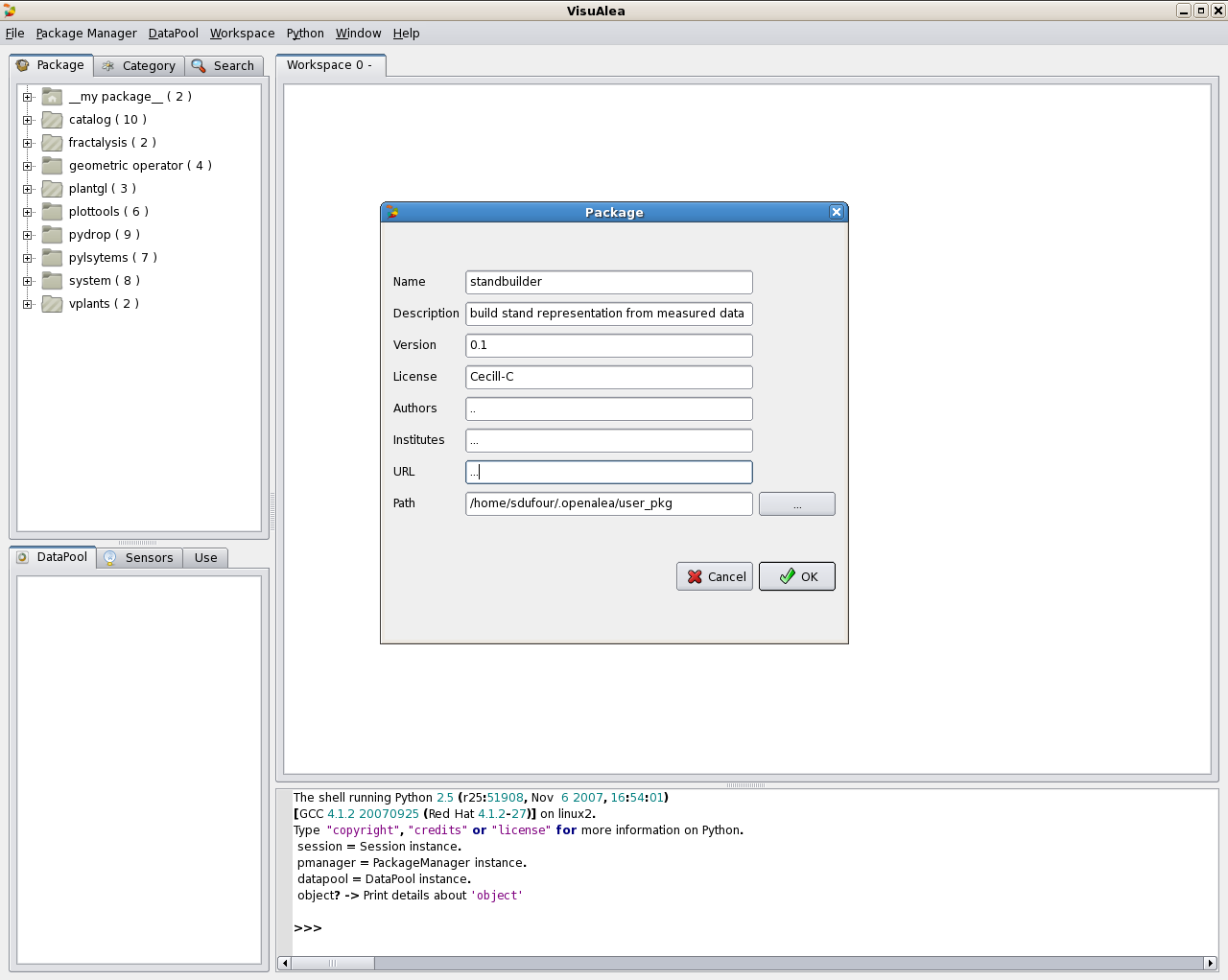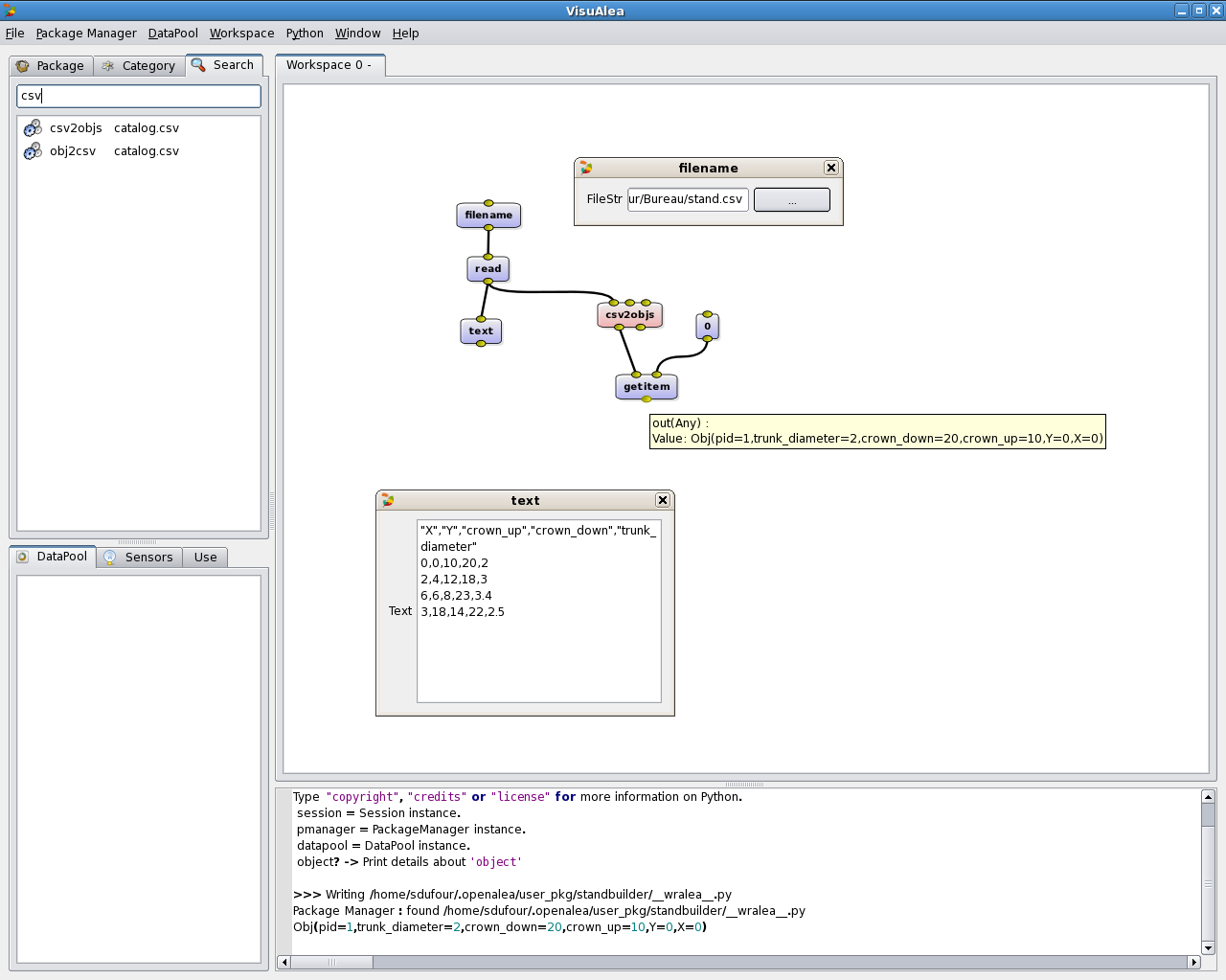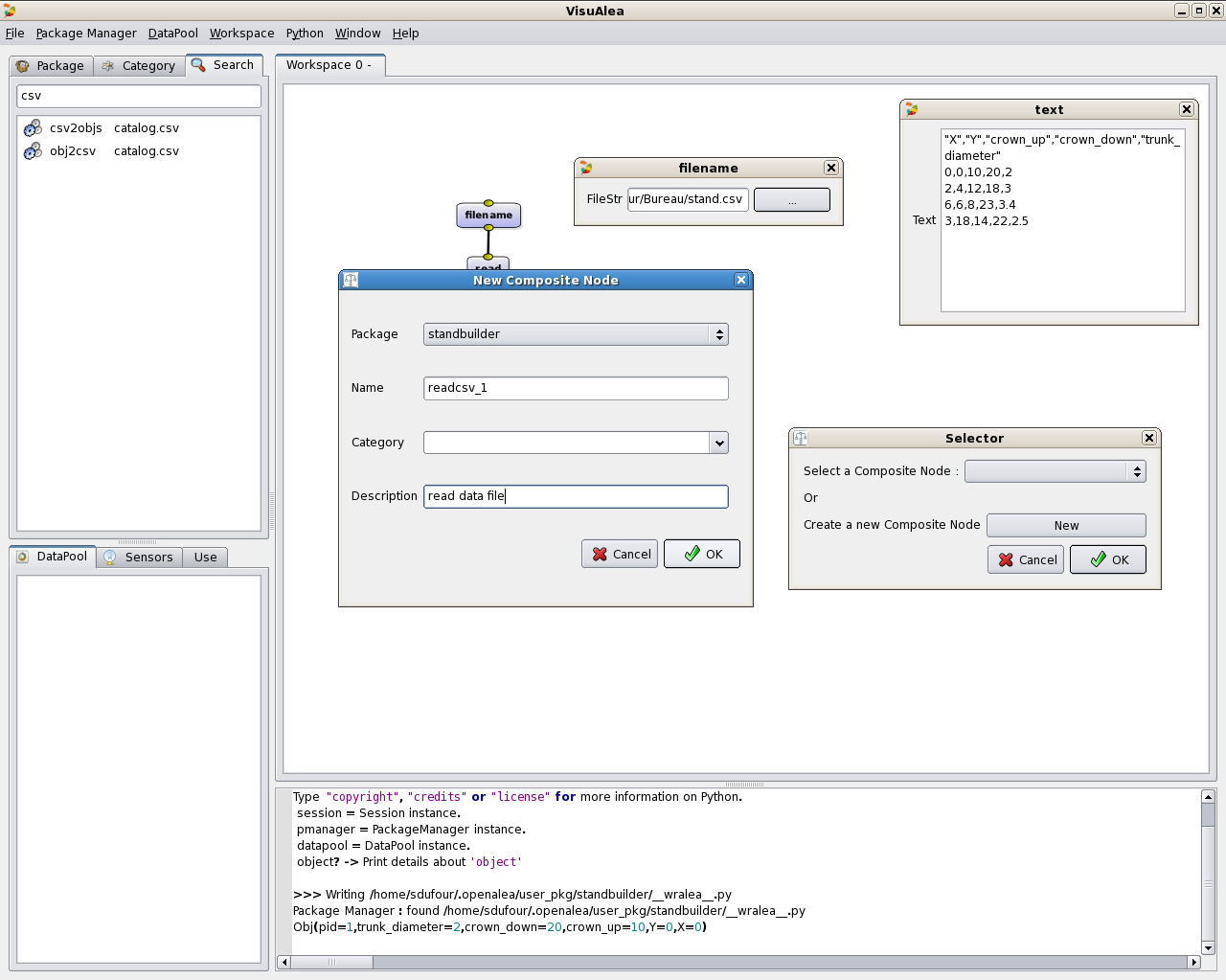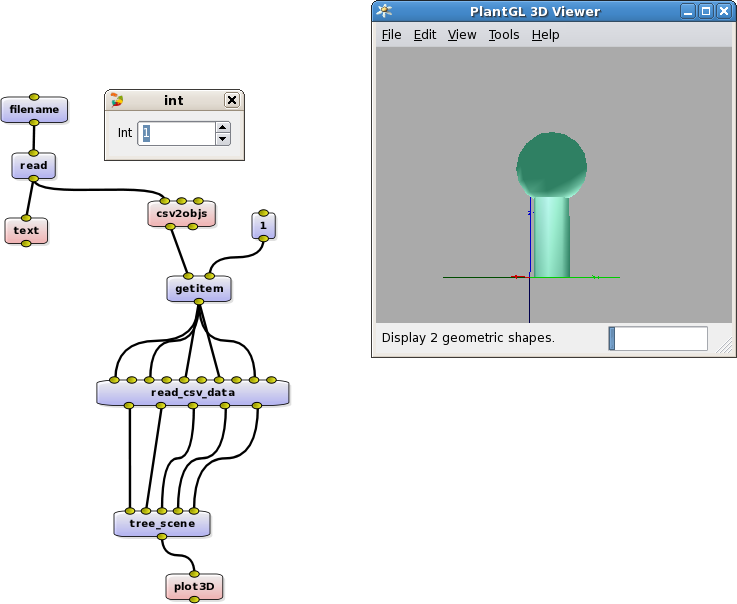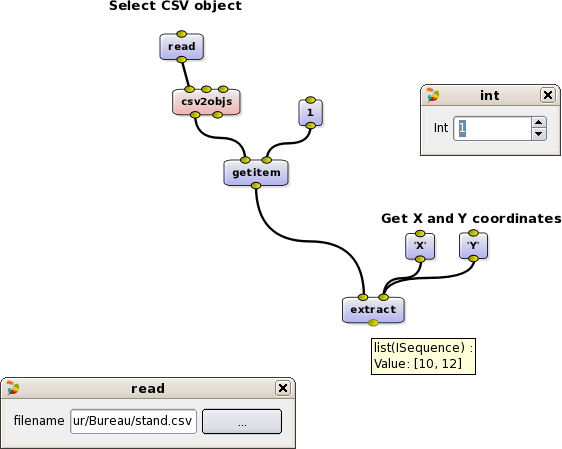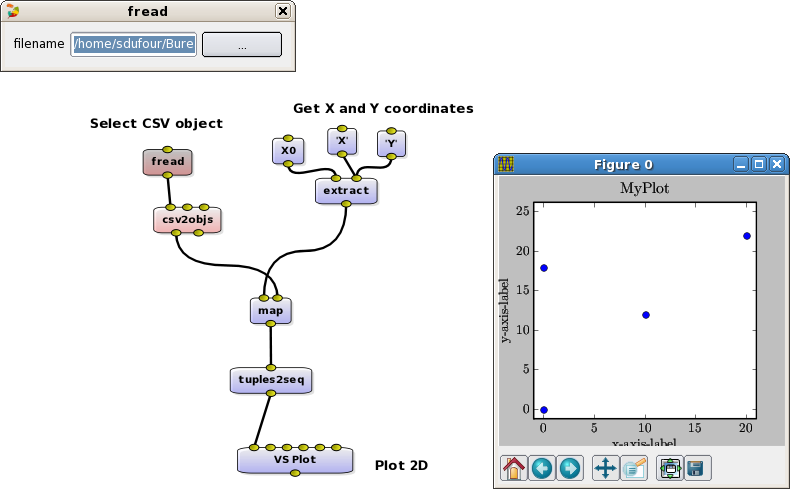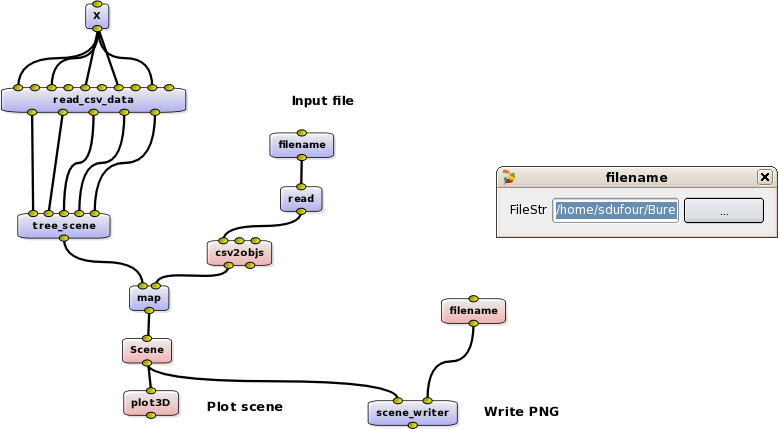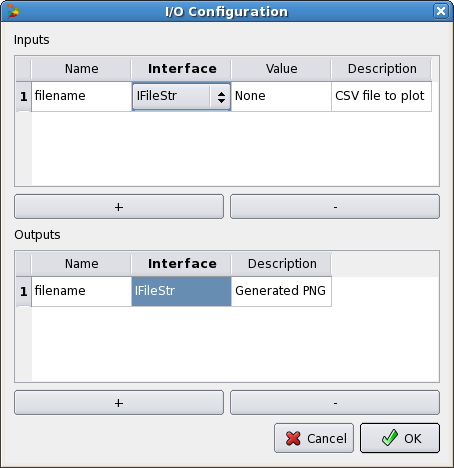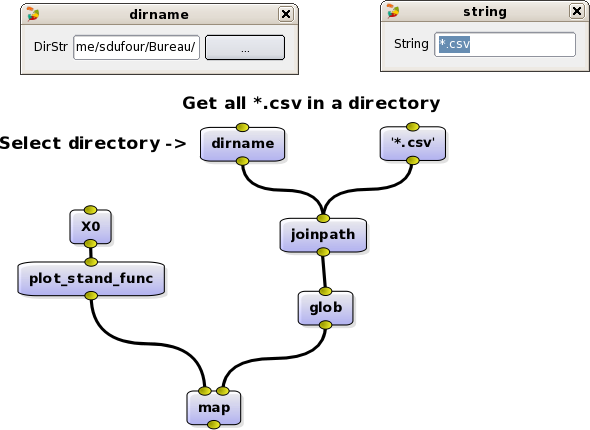Beginner's tutorial
Requirement
Download & Install OpenAlea : download
First step
Start Visualea
- On Windows : Start Menu → OpenAlea → Visualea
- On Linux (in a shell) :
[prompt ~]$visualea
Create and save your first graph
This video shows:
- How to create a simple expression by connecting nodes
- How to save your work
A more complete example
In this tutorial, we will see how to implement a simple modeling problem in Visualea.
The problem
We measured some tree data, saved in a tabbed editor (like excel). These data have been exported in a CSV file.
⇒ We want to have a simple 3D representation of the measured tree.
The data
The CSV data are :
X Y crown_up crown_bot trunk_diameter 0 0 10 20 2 10 12 12 18 3 20 22 8 23 3,4 0 18 14 22 2,5
- Download :stand.csv
- Alternatively, within openalea, this data set is also available as a data node (type stand.csv in the search panel).
Prerequisite
You need to intall on your system the following openalea packages :
- OpenAlea.Visualea
- OpenAlea.Catalog
- PlantGL
- OpenAlea.Plottools
Use OpenAlea installer to install these packages.
You will need also standard scientific python packages :
- Matplotlib
- Scipy
Use OpenAlea installer / Install Other Egg to install these packages
Step 1 : Create your own package
First of all, we need to create a package where to put your work (dataflow, node definition, data, …). A package is in fact a simple directory containing python files.
Create a package
- Select Menu package Manager → Create → Package
- Fill the form:
- Name : standbuilder
- Description : build stand representation from measured data
- Version : 0.1
- License : Cecill-C
- Authors : All collaborators and package writer
- Institutes : …
- URL : …
- Path : /home/myhome/openalea_pkg
- Click OK
Your new package should appear in the package manager.
Nota : the path correspond to directory where the python file will be written. Choose it carefully in order to be able to find it later.
Step 2 : Read CSV data
Create a dataflow to read and view a file
- Open the openalea folder in the package manager (left column)
- Open the file sub folder : should see a list of node like
readorfilename - Let the mouse pointer on a node : a tip shows informations about the object
- Drag the
filenamenode to the workspace (the white page on the right) - The
filenamebox is on the workspace. It has one input and one output (yellow circle) - Let the mouse pointer on the node : a tip shows informations about the component
- Let the mouse pointer on an input or on an output (yellow circle) : you can read, the port description and its value
- Drag the
readnode from the packageopenalea.fileto the workspace - Connect the
filenameoutput to thereadinput : drag the mouse pointer from a port to the other. - Do the same operation in order to add the node
openalea.data structure.texton the workspace - Connect its input to the output of the
readnode
View the file contents
- Right click on the the
filenameand select Open Widget - Select the file you want to read (the csv file)
- Right click on the
textnode, and select Run - Right click on the
textnode, and select Open Widget
Build a CSV object
In order to manipulate the CSV data, we are going to build a CSV object.
- Select the search tab in the package manager
- Type CSV
- Drag the
read csvnode on the workspace - Do the same to instantiate the
getitemobject (catalog.python.getitem) - Connect the
readoutput to theread csvinput, and its output to thegetitemfirst input - Add an
intobject on the workspace, and connect its output the second input ofgetitem - Execute the graph by selecting Run in the context menu of the
getitemnode - Print the output in the shell : Right click on the output port, and select print
Save your work
- Menu Workspace → Save as composite node (CTRL + E)
- In the selector dialog, click 'New' Button
- In the new dialog,
- Select the
standbuilderpackage in the combo box - Enter the name :
readcsv_1 - Add a description : Read data file
- Click
Ok
- In the selector, click
Okbutton - The new graph should appear in the
standbuilderpackage.
Step 3 : Create a simple 3D representation of one tree
Before displaying the whole stand, we must rebuild a tree. In this tutorial we build a very simple tree representation composed by a sphere for the crown and a cylinder for the trunk.
Create a 3D object
This simple dataflow shows how to display a scene object.
- First step, we create a new workspace : Select Menu Workspace → New Empty Workspace (CTRL+W)
- Create the following dataflow by using PlantGL nodes
plantgl.objects.cylindercreates a cylinderplantgl.objects.translatedmoves the input objectcatalog.data.tuple3to set the translation vectorplantgl.visualization.plot3dto view the result
Create a simple tree
To build our tree, we must construct a PlantGL scene containing a cylinder and a sphere.
- Modify the previous dataflow as follow:
- Add a
plantgl.objects.sphereobject - Add a
plantgl.objects.translatedobject - Add a
plantgl.objects.sceneobject - Connect the 2
translatedobjects to aplantgl.objects.sceneobject
- Save this dataflow in your
standbuilderpackage assimple_tree
Step 4 : Create a Macro Node / Group Nodes
We will need to use the previous dataflow to build trees. To simplify this procedure, we would like to use a simple node and not a complex dataflow. For that we are going to embed the previous dataflow in a composite node (also named macro node).
Transform simple_tree to a reusable composite node
- Open
simple_treein a new workspace (double click in the package manager on thesimple_treegraph) - Select Menu Workspace → Configure I/O
- Add 5 inputs with the
+button :- Name - Type - Default value - Description
- X - IInt - 0 - X position
- Y - IInt - 0 - Y position
- crown_up - IFloat - 16.0 - Top of the crown
- crown_bot - IFloat - 8.0 - Bottom of the crown
- trunk_dia - IFloat - 3.0 - Trunk diameter
- Add 1 output with the
+button- scene - None - PlanGL scene
- Click
OK - Modify the graph as follow
- Connect input 0 and 1 to the X and Y nodes
- Connect input 2 and 3 to a minus node
catalog.math.-, and connect the result to the crown radius - Connect input 5 to the trunk radius
- Connect input 3 to the crown bottom
- Save your work as a new composite node in
standbuildernamedtree_scene
Using the new composite node in a dataflow
- Open our first dataflow
readcsv_1in thestandbuilderpackage (doucke click) - Drag the node
standbuilder.tree_sceneon the new workspace - Add 5x
getitemand 5xstringobject - Connect the nodes as the picture in order to retrieve to different object properties
- Add a
plangl.visualization.plot3Dobject and connect it to the output oftree_scene - Run the dataflow several times and change the value of the first
getitem(object index) - Save the dataflow in the
standbuilderpackage asreadcsv_2
Create a composite node by grouping nodes
- Select the 5 get item and their associated
stringobject - Click on Menu Workspace → group (CTRL+G)
- Run the dataflow
- Save it in the
standbuilderpackage asreadcsv_3
Step 5 : Get the spatial distribution of the trees
We want to extract from the csv object the X and Y properties and plot them in 2D.
Extract data
- Create a new workspace (CTRL+W)
- Add a
readnode and acsv2objsnode to read a csv file. - Set the file to read by opening the
readwidget (open widget) - Run and Display the output (output port context menu → print or tooltip) : it's a list of obj
- Add a
getitemnode and aintnode to select an object in the list - Add an
extractnode and 2stringsnode to select properties in a particular object. - Set the 2 string object to X and Y
- Run and display the output (output port context menu → print or tooltip) : it's a list containing the X and the Y properties of the selected object.
Implement iterative process
We want to do the same thing, but for all the CSV objects contained in the file.
- Remove the
getitemand theintnodes (with suppr) - Add a
catalog.functioanl.map - Connect the output of
extractto the first input ofmap - Connect the output of
csv2objsto the second input ofmap - Add a
system.Xnode and connect its output the first input ofextract - Run the
mapobject and display the result
Nota : The X object represents a function variable. The map apply a function to each element received in its second input.
Plot 2D
- Add the nodes
plottools.VS Plotandplottools.tuples2seqon the workspace - Connect the
mapoutput the input oftuples2seqand the last output theVS Plotnode. - Run the dataflow
- Save it in the
standbuilderpackage asplot_csv
Step 6 : Apply the process to multiple trees
In this step, we used the same method to build the entire stand
- Open the
readcsv_3dataflow - Modify it in order to plot in 3D all the tree contained in the file and not only one
- Use a
system.Xnode and acatalog.functional.mapnode
- Save this work in your
standbuilderpackage asplot_stand
Step 7 : Generate a PNG image
We want to generate an image of the 3D scene. Unfortunately there is no PlantGL node to achieve this task. We need to implement our own python function to do that.
Create a python node
- Select Menu Package Manager → Create → Python node
- Fill the dialog :
- Package :
standbuilder - Name :
scene writer - Category : visualisation
- Description : write a PlantGL scene to a Png file.
- Click on Inputs/Outputs
- Add 2 inputs with the + button
- scene - None - None - the scene to write
- filename - IFileStr - None - The file to write
- Add 1 output with the + button
- filename - IFileStr - None - The written file
- Click OK on both dialog
- The new node should appear in the package manager
Edit the code of the node
- Rigth click on the node in the package manager
- Select Edit : it opens a code editor
- If your want to use your own editor, use preference dialog (Menu Window→Preferences)) to set it up.
- Edit the code :
from openalea.plantgl.all import Viewer class scene_writer(object): """ Write a plantgl scene to a PNG file """ def __call__(self, *inputs): scene = inputs[0] fname = inputs[1] Viewer.display(scene) Viewer.camera.lookAt((0,0,300),(0,0,0)) Viewer.frameGL.saveImage(fname) return fname
Use the node
- Open the
plot_standdataflow (double click in the package tree) - Drag the node
scene writerfrom the package manager to the workspace. - Connect the
Sceneoutput to the first input ofscene_writer - Add and Connect
catalog.file.filenamenode to the second input ofscene_writer - Choose a filename
- Execute the dataflow by clicking on Run in the context menu of
scene_writer - The image file have been created
- Save the composite node as
plot_stant(overwrite existing one)
Modify the node
Now we want to modify the code of the node. For instance, we want to change the camera position.
- Edit the node code by doing a right click on the node in the package tree and select Edit
- Modify the code : for instance, change the 300 by a 500
- Save the python file
- Reload the package : Right click on the
standbuilderpackage in the tree view, and click Reload : this action reload all python modules in the package, but doesn't affect the nodes in the workspace. - Reload the workspace : Menu Workspace → Reload (Warning : all the modifications which are not saved will be lost).
Exercise
- Modify the python node in order to be able to set the camera position.
Step 8 : Apply the process to several files
Create a composite node to generate an PNG image from a CSV
- Open the
plot_standdataflow - Save it under a new name :
plot_stand_func - Add an input and an output
- The input is the CSV filename (interface IFileStr)
- The output is the generated PNG
- Connect the dataflow input (in)) to
filename - Connect the
scene_writeroutput the dataflow output (out)) - Add a
catalog.string.joinnode and connect it to thescene_writersecond input - Open the
joinwidget, and delete the join character (by default, it is a 'space') - Add a
catalog.data.stringnode, set its value to '.png' and connect it to the first input ofjoin - Save the modification (CTRL+E)
Get a set of file
- Open a new workspace (CTRL+W)
- Add nodes to get a list of filenames contained in a directory :
catalog.file.globcatalog.file.joinpathcatalog.file.dirnamecatalog.data.string
- Connect them as shown on the picture
- Set the
stringto *.csv - Set the
dirnameto directory to scan - Run the
globand print the result
Create an image for each file
- Add a
plot_stand_funcnode - Add a
catalog.functional.mapand asystem.X - Connect them in order to execute the
plot_stand_funcnode for each file (see picture) - Save the dataflow in the
standbuilderpackage asgen_images - Execute the dataflow. For each csv file in the specified directory, a png image is generated.
Step 9 : Share your work with your colleagues
Share the ''standbuilder'' package
- Get the directory you saved your package (Right click on the package → meta informations)
- Copy this directory, or zip/tar it
Import a package
- Copy the directory on an other system, or unzip/untar it
- Select Menu Package Manager → Load Package/Directory : the package should appear in the tree view.
